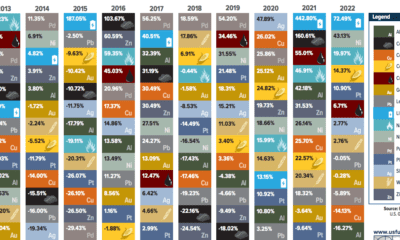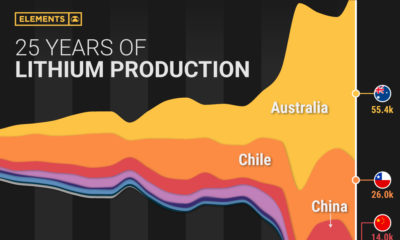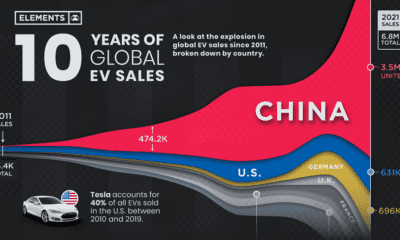Inside Tesla’s $5B Gigafactory
With $5 billion in capital expenditures and 6,500 high tech jobs, several states continue to court Tesla Motors to build their next megaproject within their borders. The Tesla Gigfactory, slated to open doors in 2017, will set a new precedent for economies of scale in battery production. Tesla’s new factory will produce more lithium-ion batteries under one roof than all of 2013’s global production combined. As a result, the electric car company estimates this will cut costs per kWh by 30%. Tesla’s product strategy relies on it. The Gen III is supposed to retail for only $35,000, which is only half the cost of the more upscale Model S. UBS notes that raw materials make up 70% of the cost of each lithium-ion battery, so sourcing and procuring these minerals will be a very important component of their overall strategy. In the infographic, we break down the potential impact this will have on these commodities. Special thanks to Simon Moores and The Gold Report, who had a great interview recently on the subject. Graphite: In 2013, flake graphite production was 375,000 tonnes. The Gigafactory alone would add another 126,000 tonnes (34% increase) over 2013 production. Even more significant, the increase on battery-grade graphite demand would be 154%. Cobalt: 55% of cobalt comes from the Democratic Republic of the Congo. Tesla says they do not source from the Congo, so this makes getting cobalt a little more difficult. 42% of cobalt demand is from batteries, making it the blue metal’s #1 use. Current Tesla batteries use about 9% cobalt by weight (NCA formulation). Lithium: There has been a steady supply of lithium in Chile since 1996, so this will likely be the easiest commodity to source.
Related Content
Infographic: 10 Mind Blowing Facts About Tesla Motors (TSLA) on
#1: High Reliability
Nuclear power plants run 24/7 and are the most reliable source of sustainable energy. Nuclear electricity generation remains steady around the clock throughout the day, week, and year. Meanwhile, daily solar generation peaks in the afternoon when electricity demand is usually lower, and wind generation depends on wind speeds.As the use of variable solar and wind power increases globally, nuclear offers a stable and reliable backbone for a clean electricity grid.
#2: Clean Electricity
Nuclear reactors use fission to generate electricity without any greenhouse gas (GHG) emissions.Consequently, nuclear power is the cleanest energy source on a lifecycle basis, measured in CO2-equivalent emissions per gigawatt-hour (GWh) of electricity produced by a power plant over its lifetime. The lifecycle emissions from a typical nuclear power plant are 273 times lower than coal and 163 times lower than natural gas. Furthermore, nuclear is relatively less resource-intensive, allowing for lower supply chain emissions than wind and solar plants.
#3: Stable Affordability
Although nuclear plants can be expensive to build, they are cost-competitive in the long run. Most nuclear plants have an initial lifetime of around 40 years, after which they can continue operating with approved lifetime extensions. Nuclear plants with lifetime extensions are the cheapest sources of electricity in the United States, and 88 of the country’s 92 reactors have received approvals for 20-year extensions. Additionally, according to the World Nuclear Association, nuclear plants are relatively less susceptible to fuel price volatility than natural gas plants, allowing for stable costs of electricity generation.
#4: Energy Efficiency
Nuclear’s high energy return on investment (EROI) exemplifies its exceptional efficiency. EROI measures how many units of energy are returned for every unit invested in building and running a power plant, over its lifetime. According to a 2018 study by Weissbach et al., nuclear’s EROI is 75 units, making it the most efficient energy source by some distance, with hydropower ranking second at 35 units.
#5: Sustainable Innovation
New, advanced reactor designs are bypassing many of the difficulties faced by traditional nuclear plants, making nuclear power more accessible.
Small Modular Reactors (SMRs) are much smaller than conventional reactors and are modular—meaning that their components can be transported and assembled in different locations. Microreactors are smaller than SMRs and are designed to provide electricity in remote and small market areas. They can also serve as backup power sources during emergencies.
These reactor designs offer several advantages, including lower initial capital costs, portability, and increased scalability.
A Nuclear-Powered Future
Nuclear power is making a remarkable comeback as countries work to achieve climate goals and ultimately, a state of energy utopia. Besides the 423 reactors in operation worldwide, another 56 reactors are under construction, and at least 69 more are planned for construction. Some nations, like Japan, have also reversed their attitudes toward nuclear power, embracing it as a clean and reliable energy source for the future. CanAlaska is a leading exploration company in the Athabasca Basin, the Earth’s richest uranium depository. Click here to learn more now. In part 3 of the Road to Energy Utopia series, we explore the unique properties of uranium, the fuel that powers nuclear reactors.






























